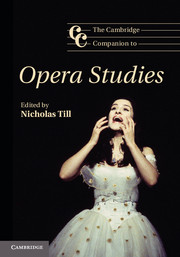Introduction: opera studies today
Published online by Cambridge University Press: 05 December 2012
Summary
In all art the road to appreciation lies through reflection.
(Stendhal, Life of Rossini)In 1860 the French poet Charles Baudelaire heard a concert performance of excerpts from Richard Wagner’s opera Tannhäuser. Writing about the overwhelming impact that the music had upon him he expressed his desire to understand better its ‘mysterious intentions and method, which were all unknown to me. I resolved to make myself master of the why and wherefore, and to transform my pleasure into knowledge.’
We could have no better account of why we might be led to study something, most particularly something that gets under our skin, as Wagner had got under Baudelaire’s skin, and as opera gets under many people’s skins. We study something firstly because we want to understand ‘the why and wherefore’ of it: why it is, and why it is as it is. We want to understand its constituents: how they are put together and why they are put together in that way. And, secondly, we want to understand why it has the effect that it has upon us, so as to know better the values that form our own subjectivity; to gain understanding of the basis of our own pleasures or displeasures, as individuals and members of particular groups and communities. And, finally, we study something for the light it casts upon the society and culture within which the object of our study exists (or existed). Even if Baudelaire didn’t express this last concern immediately, he was certainly one of the first critics to have understood how works of art tell us about their specific historical moment. These three modes of explanation broadly provide the map by which this book has been put together, indicating what I take to be the three main fields of interest in current opera studies.
- Type
- Chapter
- Information
- The Cambridge Companion to Opera Studies , pp. 1 - 22Publisher: Cambridge University PressPrint publication year: 2012
References
- 1
- Cited by

